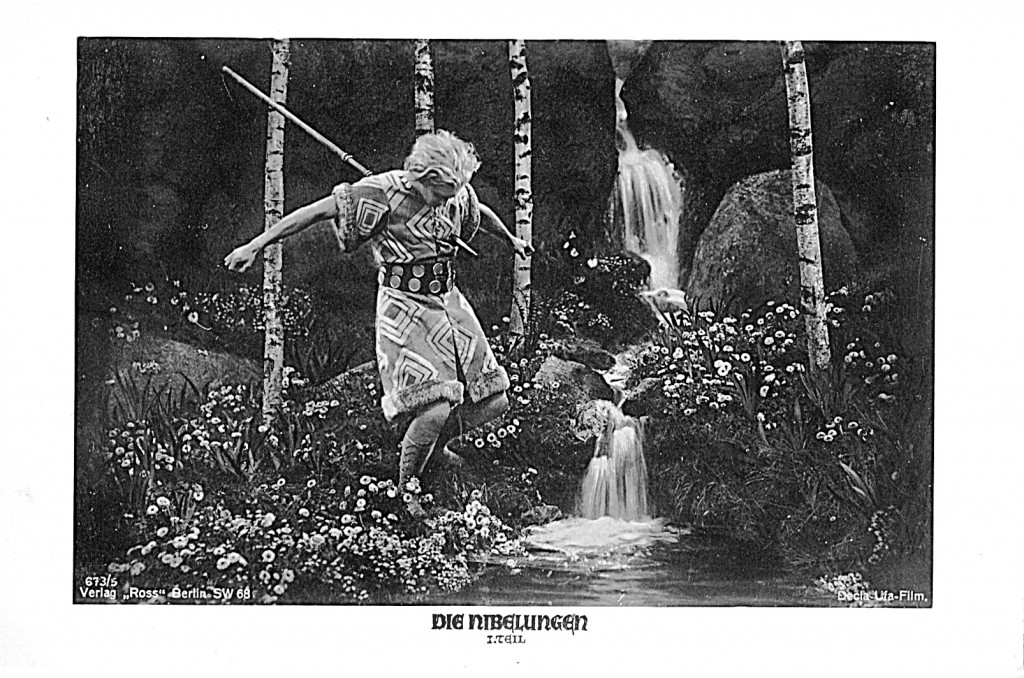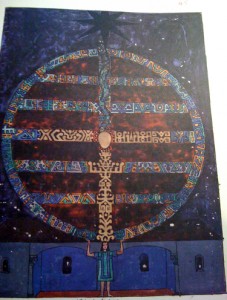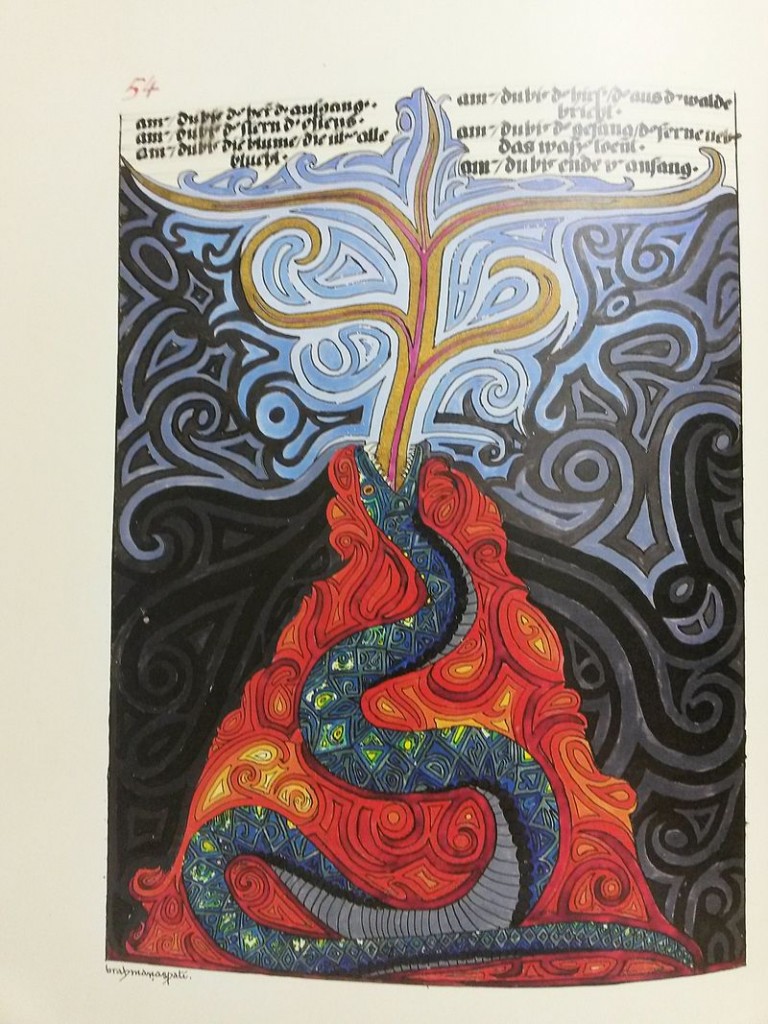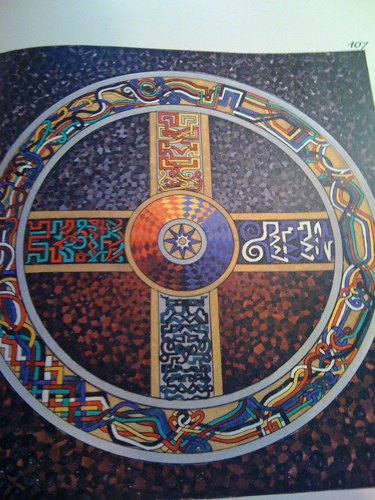There seems to be a basic misapprehension, shared by traditional religion and Romantic narrative alike, that the absolutists are the heroes. Heroes stick up for what they believe in, regardless of what fate throws at them. They continue with the quest – across the oceans, deserts, and arctic wastes – they slay the monsters, and in the end they get their reward. Or, even if the hero does not get all he desires, his beliefs are at least upheld, even if he has to die for them, for the martyr too is a hero. It’s stirring stuff, constantly reinforced for us by Hollywood, by heroic literature, even by religion.
Who could question such a narrative? Nobody should underestimate the difficulties. But one of Jung’s visions in the Red Book confronts us with their full pain.
I was with a youth in high mountains. It was before daybreak, the Eastern sky was already light. Then Siegfried’s horn resounded over the mountains with a jubilant sound. We knew that our mortal enemy was coming. We were armed and lurked beside a narrow rocky path to murder him. Then we saw him coming high across the mountains on a chariot made of the bones of the dead. He drove boldly and magnificently over the steep rocks and arrived at the narrow path where we waited in hiding. As he came round the turn ahead of us, we fired at the same time and he fell slain. thereupon I turned to flee, and a terrible rain swept down. But after this, I went through a torment unto death and I felt certain that I must kill myself, if I could not solve the riddle of the murder of the hero. (p.161) Jung is slaying, not a literal hero, but the archetype of the hero within himself. The belief that the hero will always succeed against the conditions, and that his desires and beliefs are intrinsically right according to some assumed cosmic law, is one that we may implicitly indulge every time we get caught up in the hero story. Not only do we absolutise the hero himself, but we may also identify ourselves with him. But if we are to recognise the limitations of this reassuring fantasy, we have to be able to recognise that the hero may be wrong in his assumptions. To recognise this may feel extremely painful, and the death of the hero symbolises this pain. The myths provide us with this death story as well as with the achievements of the hero, giving us the resources of meaning to be able to recognise it, but we may still have to go through that shock of dis-identification.
Jung is slaying, not a literal hero, but the archetype of the hero within himself. The belief that the hero will always succeed against the conditions, and that his desires and beliefs are intrinsically right according to some assumed cosmic law, is one that we may implicitly indulge every time we get caught up in the hero story. Not only do we absolutise the hero himself, but we may also identify ourselves with him. But if we are to recognise the limitations of this reassuring fantasy, we have to be able to recognise that the hero may be wrong in his assumptions. To recognise this may feel extremely painful, and the death of the hero symbolises this pain. The myths provide us with this death story as well as with the achievements of the hero, giving us the resources of meaning to be able to recognise it, but we may still have to go through that shock of dis-identification.
Jung identifies the death of the hero with the archetypal role of Christ, whose crucifixion plays a similar role: showing us that our absolutised idea of a human God must die so as to lead us on to an engagement with God that is no longer based solely on human projection. Jung puts it this way:
I must say that the God could not come into being before the hero had been slain. The hero as we understand him has become an enemy of the God, since the hero is perfection. The Gods envy the perfection of man, because perfection has no need of the Gods. But since no-one is perfect, we need the Gods. The Gods love perfection because it is the total way of life. But the Gods are not with him who wishes to be perfect, because he is an imitation of perfection. (p.171)
‘The Gods’ here are symbolic of our own wider recognition – of the limitations of our current egoistic view of ourselves and of our greater potential as more integrated beings. We do not attain perfection merely by imitating, because the model we imitate may have worked in the conditions it was produced but is unlikely to work in the very different conditions of our own lives. Only integrated creativity will do, and that requires us to let go of our identification with all heroic models of imitation.
Strangely enough, though, there seems to be an even greater heroism involved in this process. What could be more heroic, itself, than killing the hero? But if we reduce this to another model of imitation, an absolute set of beliefs about how the world is and how we should act in it, then we will find this new heroism just as limiting in the end, and find ourselves in a cycle of endlessly killing new heroes. The killing of the hero needs to be accompanied by the further development of integration in experience so that we come to rely positively on that rather than on absolute beliefs about the hero. Our heroism needs to become agnostic, but such heroism can be seen, not as abandoning heroism, but as finding a deeper and more adequate form of it.
I have often been puzzled by the way that agnosticism is frequently portrayed in popular discourse, as the very opposite of heroic. As Richard Dawkins describes agnostics (quoting a preacher with approval): “Namby-pamby, weak-tea, weedy, pallid fence-sitters” (The God Delusion, p.69). The assumption here seems to be that agnostics dare not attempt the heroism of belief, whereas I want to suggest that on the contrary, agnostics are even more heroic than the heroes caught up in their righteous assumptions. The dogmatic hero carries on against adversity in the certain feeling that God or the universe is on his side. The agnostic hero, on the other hand, has to manage without such delusory certainties, managing only with hope and embodied confidence. Nothing can be taken as determined about her success in the goals she takes up, and even those goals themselves have to be taken as provisional ones. The greatest hero ventures into the lands of uncertainty, and rather than just slaying the monsters, has the courage to question her own monstrous projections.
It is upsetting to find people like Richard Dawkins failing to recognise the heroism of agnosticism, when that very heroism is so central to science. The scientist always has to proceed in conditions of uncertainty, unless she constructs deluded assumptions of naturalistic ‘truth’ where none are available to us. The use of scientific method is distinguished for its heroic agnosticism. But this heroic agnosticism can also be a distinguishing feature of the very ‘religion’ that Dawkins so despises. The mystics, too, proceed on the basis of a faith that grows from their experience of what they call God, and have to slay their own heroic certainties in order to plunge into the cloud of unknowing. Religious believers and scientists alike may have to slay their own heroes on order to go on to a deeper recognition of human potential.
Picture: The death of Siegfried (public domain)



